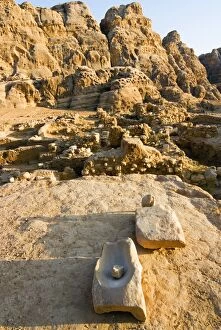Grindstone Collection (page 3)
"Unveiling the Timeless Art of the Grindstone: From Persian Women to Dickens' Novels" Step into a world where time seems to stand still
All Professionally Made to Order for Quick Shipping
"Unveiling the Timeless Art of the Grindstone: From Persian Women to Dickens' Novels" Step into a world where time seems to stand still, as Persian women gracefully maneuver a large grindstone in Iran. The rhythmic motion of their hands transforms farming and sharpening tools, breathing life into their daily tasks. Transport yourself back to 1910 with an enchanting illustration from Charles Dickens' masterpiece, "A Tale of Two Cities. " A captivating engraving captures the essence of an era when grindstones played a vital role in shaping society's progress. Marvel at the Saint Bartholomew Altarpiece, created between 1500-1510 by the Master of the Sa. This exquisite artwork showcases tradesmen skillfully honing scissors on a Christmas card, reminding us that even during festive times, dedication and craftsmanship never wavered. Embark on a zigzag journey through Mexico in 1875 with Thomas Mayne Reid's depiction of "A Kitchen in the Tierra Caliente. " Witness locals diligently grinding away at their grindstones, illustrating how this timeless tool transcended borders and cultures. Delve into social commentary with "Grinding Away; or, The Road to Starvation, " a color lithograph highlighting societal struggles. As Samson labored on his treadmill in 1754's oil painting, we are reminded that sometimes survival depends on relentless effort against all odds. Charles Emile Jacque's poignant piece titled "The Knife-Grinder" transports us to 1850. With every turn of his wheel and sparks flying from blades meeting stone, we witness both physical labor and metaphorical resilience etched onto this canvas. Discover ancient civilizations through ceremonial grinding tables (metates) dating back centuries. These magnificent artifacts take various forms - from feline-inspired designs between AD 500-1000 to unknown creators' masterpieces spanning AD 1-500 - showcasing humanity's ingenuity and reverence for the grindstone.
















